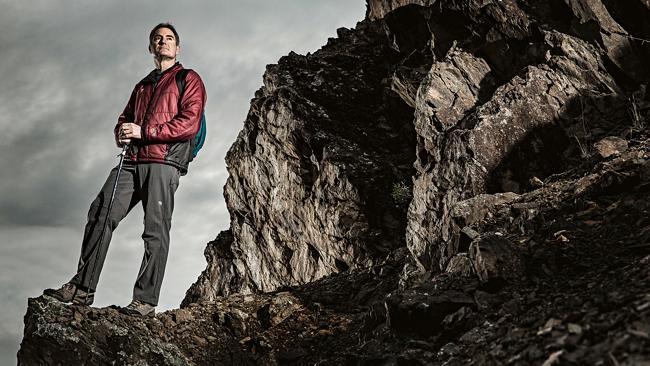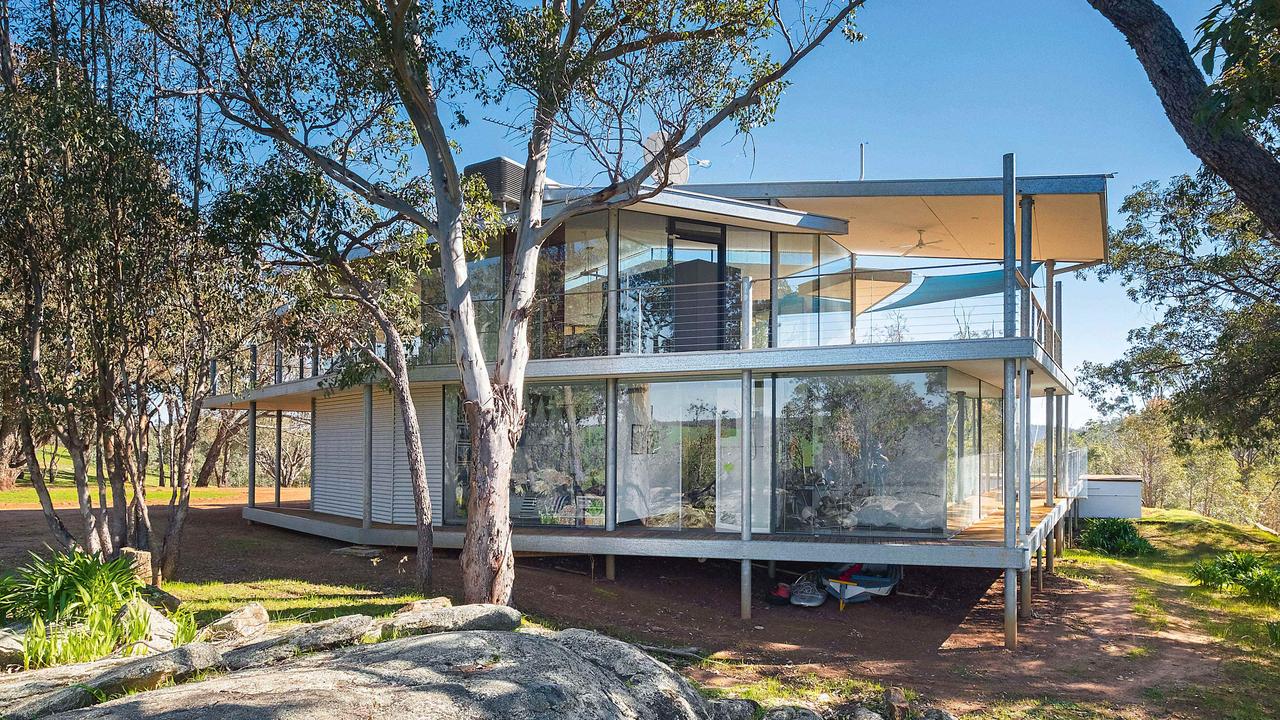High drama for mountaineer Andrew Lock
ANDREW Lock is the only Australian to summit all 14 of the world’s 8000m mountains. But his first conquest was almost his last.

FALLING! A nearly vertical ramp. I flail desperately with my ice axe, but it bounces off impenetrable rock and the abyss below rushes at me like a black hole that sucks everything into its void.
I thrash desperately, clawing at the thin covering of soft, wet snow — my only hope of stopping the fall. Still sliding, I kick my feet out wide, using my legs to catch more of the snow beneath me. It’s a risk — if I build up too much snow underneath me I’ll topple over backwards and lose all control. But it’s a risk worth taking; if I don’t stop right now, I am dead anyway. Nothing. Still sliding. A thought flashes through my mind: Christ, it’s all over …
Then I sense the slightest slowing. The snow beneath me forms a small wedge between my legs. The buildup between my arms gives me enough balance so I don’t topple backwards. Slowing, slowing … stopped. Temporarily safe, my body remains in overdrive. I gasp so fast that I literally scream for breath. Sucking in great frozen lungfuls, I cough violently as the cold, dry air tears at my throat. My heart pounds so hard my chest hurts.
I latch on to the mountain like a drowning man clutches a plank. Get yourself together. Get control. Ever so gradually the tension eases, my heart slows, my reeling head steadies, my gasping reverts to simple panting. I cough again and spit thick, bloody sputum into the ice in front of me. My face drops into the mess, but I don’t care. Breathing is all that matters.
I am still alive. Still. For this has not been an isolated slip that nearly ended badly, it’s been my descent for the last hour. A frantic, desperate series of uncontrolled leaps of faith. No, not faith, but hope. It is a hope born of hopelessness, as there is no other way down. I can stay up here and die in the thin air, or take my chances.
I am unprepared for this. I’ve spent too long at high altitude. I’m tired and dehydrated, exhausted from what has already been 18 hours of climbing above 8000m without supplementary oxygen. I’m way too inexperienced to have any right to be here. This has been my first successful 8000m summit and it is on the majestic but notorious K2, which sits on the border between Pakistan and China. I can already hear the veterans laugh: “You climbed K2 for your first 8000m summit? Are you crazy?” Maybe.
In 1985, a door opened to a path that would dictate my life’s journey. Tim Macartney-Snape and Greg Mortimer, the two successful summiters of the 1984 Australian expedition to Mount Everest, came to Wagga Wagga where I was working as a policeman to present a slide show about their climb. It was as if an act of destiny had brought me there. Those images of massive exposure, bitter cold, objective dangers — of human fortitude against the elements in the toughest environment conceivable — drew me in like a magnet and I decided on the spot that I must experience all that myself.
I decided the best approach was to break the main objective of climbing Mount Everest into shorter-term, more achievable goals. First I would learn to rock climb, then alpine climb, then enhance my planning and organisational skills, before experiencing medium altitude and then the high altitude of the Himalaya. I did that for the next nine years, climbing around the world until I found myself here, on a July morning in 1993, ascending K2 — second only to Everest in altitude and generally considered to be the hardest mountain to climb on Earth.
I was climbing with a German team: Reinmar Joswig and Peter Metzger were the joint leaders of the expedition and their friend Ernst Eberhardt, 50, was the other German member. He had struggled with the altitude and had pulled out of the ascent at Camp 2. The fifth climber was the mighty Russian Anatoli Boukreev, a mountaineering celebrity.
From Camp 4, the route to the summit was laid out before us: a steepening slope of snow and ice to a narrow chimney called the Bottleneck, followed by an exposed traverse beneath a massive, 100m-high serac — an unstable block of ice — to a steep snow gully that led up to the long, easier-angled slopes of the summit pyramid and finally the summit itself. I was excited but also intimidated. Do I actually have what it takes to summit this mountain?
As we moved onto the steep ramp that would take us up beside the ice cliff and towards the final summit ridge, we found ourselves flailing, virtually swimming, in unconsolidated wet muck. Beneath the wet snow was smooth rock into which our crampons could not penetrate a millimetre. For every two feet we clawed our way up we’d slide back one, two or sometimes even three feet. If we slipped too heavily, we knew we’d fly straight down the slope and over the buttress, perhaps bouncing a couple of times before landing at base camp, now three vertical kilometres below. There would be plenty of time to think about it on the way down. By now Reinmar had dropped back and joined two Scandinavians who were climbing behind us.
We were at an altitude of 8300m and climbing more strenuously than I could have imagined. My lungs heaved to the point that I nearly blacked out and my heart was pounding so hard that my chest hurt. I honestly expected to have a heart attack at any moment.
Finally, exhausted beyond words, I reached the top of the slope and fell to my knees. With my last vestiges of strength I could now hold aloft my Australian flag and slap the backs of my friends in celebration. And then I looked up … and up. What I’d thought was the summit was just the start of yet another long slope that stretched into the sky — the true summit was still hours away. The realisation was soul-destroying. But exhaustion was no reason to stop. I wasn’t on the mountain to nearly summit, I was there to actually summit. We continued.
At nearly 8600m, and without additional oxygen, Peter, Anatoli and I were all now seriously hypoxic. The climb seemed interminable, but at 5pm, 13 long hours after we’d set out from Camp 4, and six hours after I’d mistakenly thought we were at the top, the ridge flattened and we finally stood on the summit. The real summit. Too tired to cheer, we hugged each other and took photos, one of which I shall always cherish. It is of Anatoli and me, together, on the top. I’d reached the summit of my first 8000m mountain and I’d done it with perhaps the strongest high-altitude mountaineer in history. Not a bad way to start the game.
We spent 20 minutes on the summit, in beautifully calm conditions. The sun was settling low in the sky and we were certain to be caught by nightfall. I wasn’t too fussed by that, knowing the full moon would soon rise and the weather was perfect. Peter and Anatoli started their descent back to Camp 4, but I decided to enjoy the view a little longer.
As the sun set, the enormous shadow of K2 stretched out for hundreds of kilometres across the Karakoram mountain range and into China. I was aware it was a sight that few in the world would ever see.
As I was preparing to begin my descent, a climber with the Scandinavian team behind us, Rafael Jensen, arrived on the summit. I took some photos for him and he told me he’d wait for his friend Daniel Bidner to summit, as he was close behind. I began making my way down. About 7pm, a little way above the top of the snow ramp that had caused me so much trouble on the way up, I came across Reinmar, the joint team leader from our group. He was clearly very tired. I asked him whether he should consider going down but he wasn’t in the mood either for the question or for a debate about it.
It was a tough situation. I could see Reinmar would struggle to make it to the top and back to Camp 4, and by then the night was upon us. But I couldn’t force him to go down; it was obvious he hadn’t lost the capacity to make a sound decision, so he had every right to decide to press on. I wished him the best, eased myself over the edge and started down the snow ramp. It was terrifying, but there was no other way down.
Every step was the same: step down … slide, scrabble frantically, slide — “F. k … f. k, stop!” – still sliding … a slight slowing, slowing, stop. My breathing was hysterical, my heart pounding. I was drenched in sweat despite the minus-20°C temperature. I kept on in this way, adrenalin pumping through my body with every barely controlled slide, until I’d done it. That’s when the sense of accomplishment at having summited the mountain hit me. I was alive and uninjured. Life was good. What a great adventure!
My euphoria disappeared as I approached our tent at Camp 4 and heard Anatoli’s voice: “Peter, is that you?” I knew immediately that Peter Metzger was dead. There could be no alternative. Clutching at hope alone, Anatoli and I scanned the slopes above and below, but Peter was nowhere to be seen. We knew now that he never would be. At some point on the descent, as Anatoli went ahead, Peter had fallen. There was nothing to be done.
Finally, at 4am, a figure in red staggered into camp. It was Rafael Jensen, the climber who had summited just after me. He was distraught but could not speak. He lay on the snow for 10 minutes drinking the hot water we passed him before he could finally muster the energy to talk. “Rafael, have you seen Peter?” I asked.
“What? No, not Peter. It’s Daniel.”
The cold sense of dread I’d felt when we’d realised that Peter was missing became even colder. “Rafael, where is Daniel?”
“He fell.”
“What happened?”
“He was slow,” Rafael panted. “I think cerebral oedema [an altitude-induced build-up of fluid on the brain]. I got him down the slope to the Bottleneck. He held onto a rock but it came loose. He fell off the cliff. He’s dead.”
Anatoli burst in: “Did you see Reinmar?”
“He summitted, but after that I don’t know.”
Daniel Bidner’s death was tragic, but we had still not accounted for Peter or Reinmar. In the emerging dawn, we searched the slopes above us for several hours, but there was no sign of either of them. There never would be.
An expedition that had been an amazing success just hours earlier had turned into a disaster. Half of the six of us who’d summited had been killed on descent. Anatoli was distraught. Reinmar had been a close friend of his. He wanted to wait at Camp 4 in case some miracle of survival occurred. I held no such hopes, but in any case my decision was soon made for me. Rafael, who’d been standing outside our tent, suddenly toppled over and lay still on the snow. He too had fallen victim to cerebral oedema. His only hope for survival was descent.
With an arm around him, I forced him to walk down the slopes towards Camp 3. I wasn’t gentle, but I knew the situation was desperate. I’d been at extreme altitude long enough to be affected by oedema, too, and if I collapsed we were done for. After a perilous descent I was relieved beyond words to see a couple of British climbers making their way up from Camp 3 and I gratefully handed Rafael over to them.
Our ascent of K2 had been achieved within just 24 days of arriving at base camp, which was very fast. However, that speed had perhaps contributed to the tragedy. No further expeditions would summit K2 that year, and it was probably just as well. Of the 12 climbers who reached the summit that season, five were killed on descent. Three of those deaths occurred during my own summit climb and were very much a part of my experience. The deaths had little immediate impact on me, though. On the descent to Camp 3 I’d been too focused on keeping Rafael alive and once at base camp, I was too exhausted to think, let alone grieve.
When I finally awoke after three days of sleep and we placed the plaques on the memorial, I still didn’t feel too much. I thought that I ought to feel something, but I also knew that I could not allow myself to. The loss was theirs, not mine. My subconscious was in control. I could not allow myself to feel any emotion.
Edited extract from Summit 8000 by Andrew Lock (MUP), $29.99


